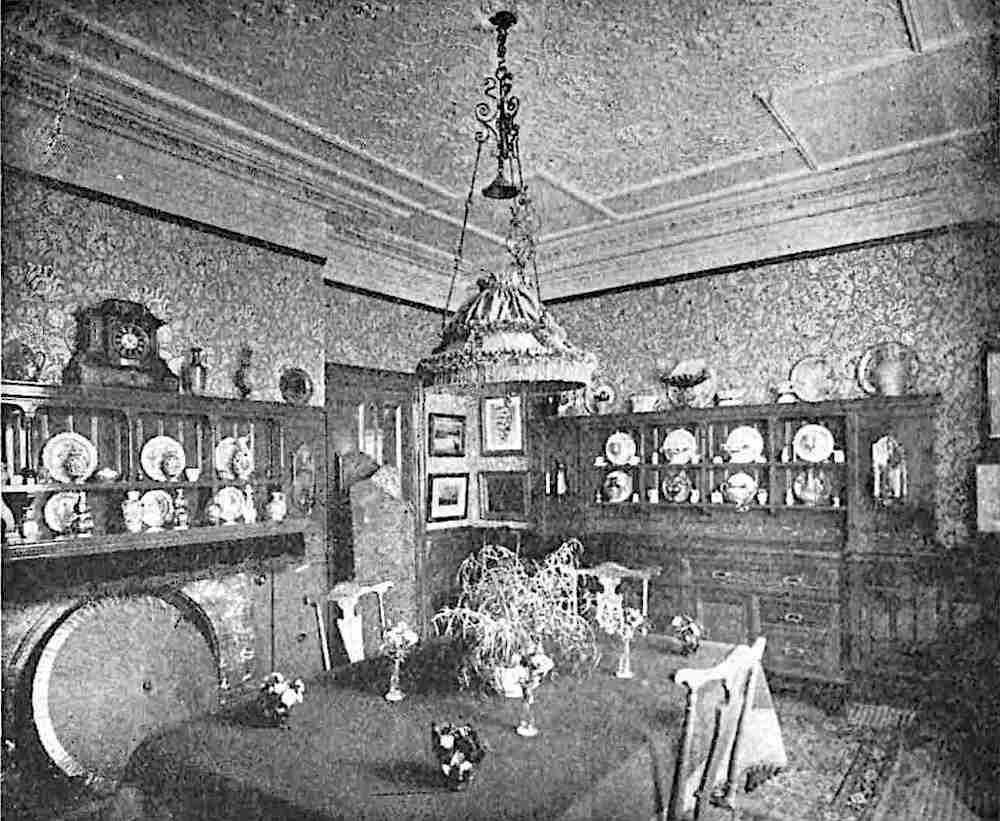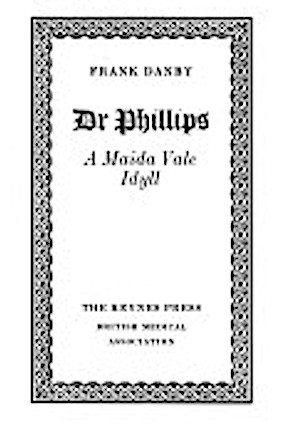This review is reproduced here by kind permission of the online inter-disciplinary journal Cercles, where it was first published. The original text has been reformatted and illustrated for the Victorian Web by Jacqueline Banerjee, who has also added captions and links. Click on the images for larger pictures.

What Sarah Bilston's book does not promise, but delivers, is actually a female history of the suburbs in Victorian literature and culture. Starting from the commonplace vision of suburbia as "an architectural blight, a cultural wasteland, a national embarrassment" (1) which appeared as early as the 1820s, she shows that this phenomenon took as many different forms as there were suburbs, and that it implied far less standardisation than was generally thought. The negative perception was not only related to class — though the reproach of stultifying dullness addressed to suburban life did embody the elite's anxiety about the middle class and its rise — but also to gender: current stereotypes depicted the suburbs as the realm of predatory women constantly on the look-out in order to trap innocent clerks looking for lodgings. However, Bilston contends that there already existed in the Victorian age another discourse which presented suburbia as a place of opportunities, of new life choices; more precisely, women writers painted a different picture and showed that Camberwell or Maida Vale (the book deliberately limits itself to the region surrounding London) could be supportive communities where the creativity of women was free to flourish. In her book, novelists like George Gissing, or George and Weedon Grossmith — the authors of Diary of a Nobody — only play second fiddle: they are regularly referred to, but mainly as counter-examples to that positive female voice which is here privileged.

A row of houses in Bedford Park, with pleasant front gardens.
To be honest, the first chapters are at least partly devoted to male writers. Chapter 1 is all about John Claudius Loudon (1783-1843), whose Suburban Gardener (1838) was full of advice for amateur landscape designers. "Forging an ideal of middle-class identity" (30), Loudon celebrated the feeling of connectedness one could enjoy in the suburbs, notably through the practice of gardening which, according to him, was not to be considered a male preserve. Curiously, the posthumous edition of his book, supervised by his widow in 1850, reflected the possible gentrification of suburbia: the title had been changed to The Villa Gardener and the volume now targeted ladies of leisure rather than proto-professional women actively using their pruning shears and digging spades.
In Chapter 2, Sarah Bilston shows that the hatred of suburbia which became particularly striking at the turn of the century was not an exclusively modernist or anti-Victorian trend. Right from the 1820s, protests were raised against the commercial utopia in newspapers touting "desirable properties." Interestingly, that was also the moment when the word "stereotype" acquired its metaphorical meaning. From a strictly technical term in the printing jargon, it came to designate a ready-made, repetitive phrasing, the two senses being united in relation to the suburbs: just like the mechanical reproduction of the same prose became common use in advertising, the endless rows of identical houses became a stereotype for the purlieus of any metropolis. Instead of being sanctified, home was commodified, as shown by Bulwer-Lytton in novels like The Disowned (1829) or Night and Morning (1841). Such fictions traced "an arc of hope to disillusionment" (51), their narrative voices being those of older, wiser men who told how they had been deceived by the false promise of suburbia.
Chapter 3 is where the book reaches its tipping point and becomes exclusively interested in female writing. Devoted to popular fiction, it deals with the need to restore social legibility, to provide anchorage in a moving world. The plot of most suburban novels starts with a (male) newcomer who has to interpret a suburb at the same time as he is interpreted by its inhabitants. The hero in William Wilkie Collins's Basil (1852) displays a lack of familiarity with social codes which prevents him from knowing "what and who is worthy in the suburbs" (59). On the contrary, Emily Eden's Semi-Detached (1859) depicts a space which facilitates connection for women: the book's aim is to "siphon off pressure in the face of increasing social plurality" (68). In Bertha Buxton's Great Grenfell Gardens (1879), feminine networks make unlikely meetings possible.



Jane Ellen Panton gives examples of ways to decorate "the ordinary suburban house" (a) Dining-Room at Wayside (106). (b) An advert at the end of her book encouraging DIY staining of floors and furniture by the ladies of the house. (b) Drawing-room at Wayside (132).
In Chapters 4 and 5, "how-to books" are studied as providing guidance to women readers in order to give free rein to their creativity and to access professional status. Interior decoration was seen as a way of rescuing society from commodity culture, indoor originality allowing women to fight against the exterior anonymity of buildings. In her books of advice, Jane Ellen Panton describes the work of interior decoration as an adventure, a moral campaign of "subjugation, civilization, control" (82). The home turned out to be "a scene of conflict and overcoming" where women could "subdue the forces of speculation and capitalist industry," prevent them "from invading family life" and test their own "resolve and self-discipline" (83). The same was true of gardening, which "authorized women to engage in physical labour, aesthetic debate, and technological innovation" (117), thus leading to their professionalisation, Gertrude Jekyll being a case in point.
Chapter 6 comes back to literature, focusing on the work of sensational novelist Mary Elizabeth Braddon (1835-1915). The most famous of her (anti-)heroines remains Lady Audley, a character who is explicitly introduced as a deceitful façade like those of suburban houses. Everything about her is too new, too clean, without the polish of fond memories of the past, just like the furniture and wallpaper of those "houses to let" which all looked identical. Sarah Bilston also examines the metaphor of the pear tree, which recurs in several of Braddon's novel as the incarnation of "the challenges of suburban life and labour" (165). The author of The Doctor's Wife (1864) preached self-discipline to resist the lure of vulgar consuming and celebrated the diversity of suburbia, against those who reduced it to stereotypes.

Julia Frankau's ironically entitled Dr Phillips: A Maida Vale Idyll, which Bilston describes as "infamous and sexually frank" (200). Source: Google Books.
In Chapter 7, Bilston opposes Jane Ellen Panton and Julia Frankau, who illustrate various ways of self-recreation and "performing suburban identity" (177). The daughter of famous painter William Powell Frith, Panton used multiple writing personae and narrative forms to echo "her own life experience of circling, emotionally and geographically" (197). A suburban Jew, often writing under the masculine nom-de-plume of Frank Danby, Frankau betrayed a sort of self-hatred while expressing her fear of seeing suburbia give in to Philistinism.
In her final "Conclusions," Sarah Bilston sums up the main points of her argument, reminding the reader once more that, despite the negative image of the spider-woman luring her preys into the dullness of constricted domesticity, the suburbs were a space where women could find friendship, and where their amateur creativity could eventually be harnessed into professional activity. "Et in suburbia ego" (165)? One should not forget that the land of prosperous housewives could also be the place of Dead-Sea Fruit, to quote the title of one of Braddon's novels, of fake fruit (but, in the pre-petroleum era, waxen rather than "plastic" ones, contrary to what is written on page 10). And yet, once women had been given spades to cultivate their gardens, they would soon "outgrow the villa" (218) and go beyond work in the (suburban) home, joining the tribe of commuters to find a job in the city, away from suburbia.
Related Material
- Garden Suburbs: Architecture, Landscape and Modernity 1880-1940
- Bedford Park, London's First Garden Suburb
- [Review by Sarah Bilston of] Laura Whelan's Class, Culture and Suburban Anxieties in the Victorian Era
Bibliography
[Book under review] Bilston, Sarah. The Promise of the Suburbs: A Victorian History in Literature and Culture. New Haven and London: Yale University Press, 2019. Hardcover. viii+282 pp. 20 black and white images. ISBN 978-030017933. $40/£30.
[Illustration source] Panton, J. E. Suburban Residences and how to Circumvent Them. London: Ward and Downey, 1896. Project Gutenberg. Web. 25 April 2019.
Created 25 April 2019